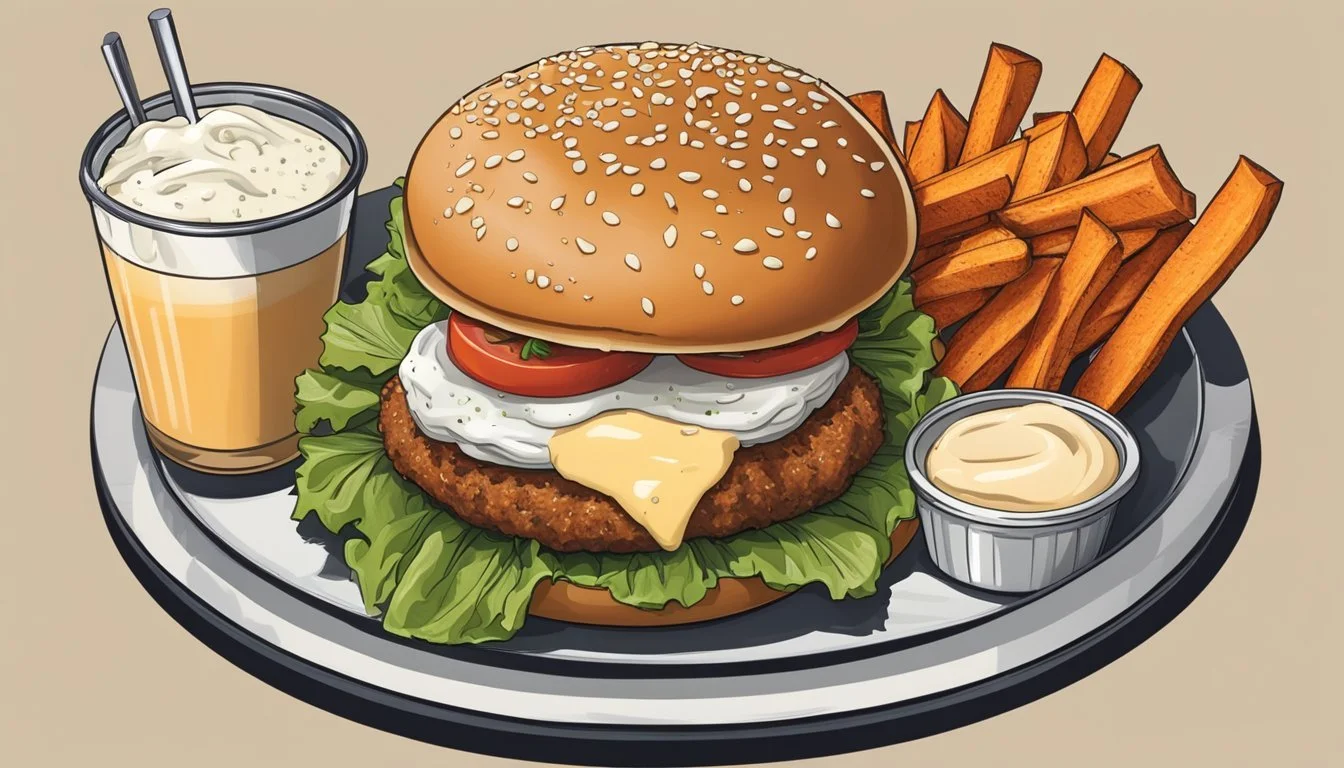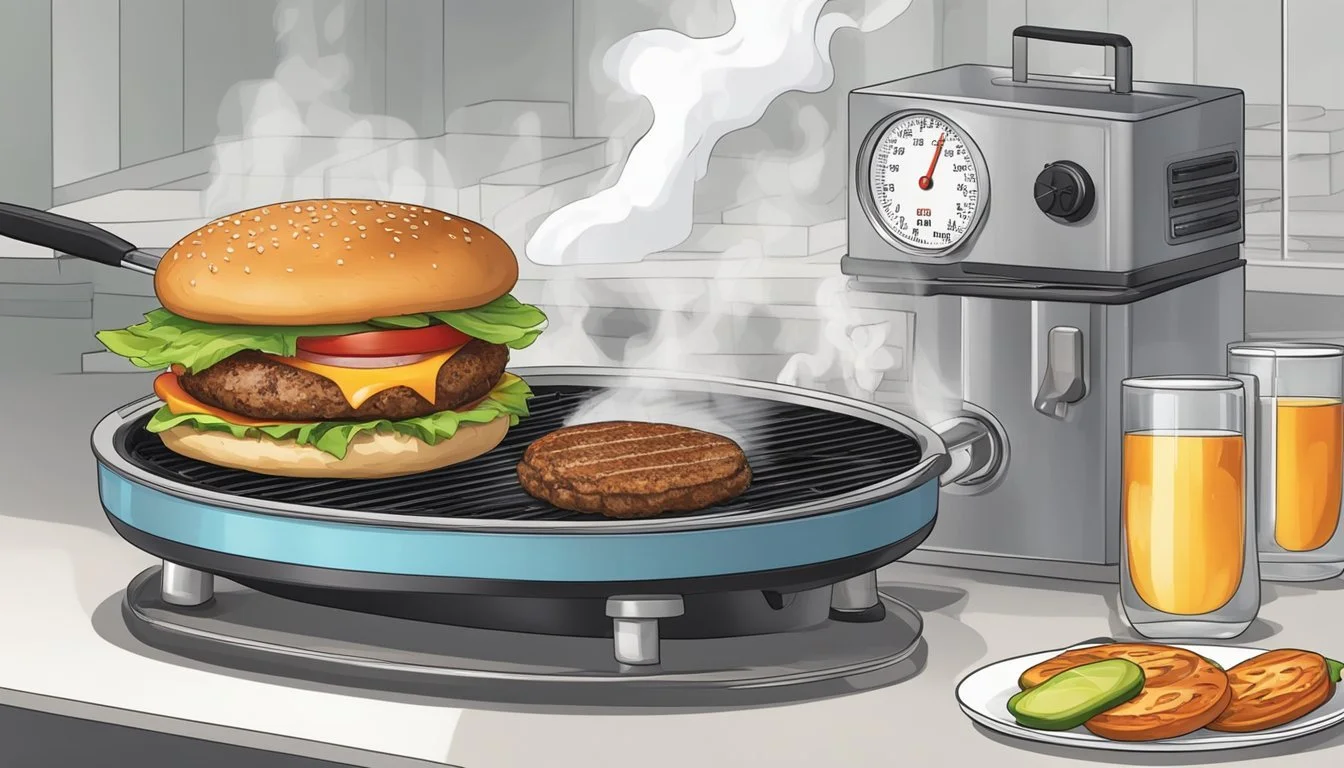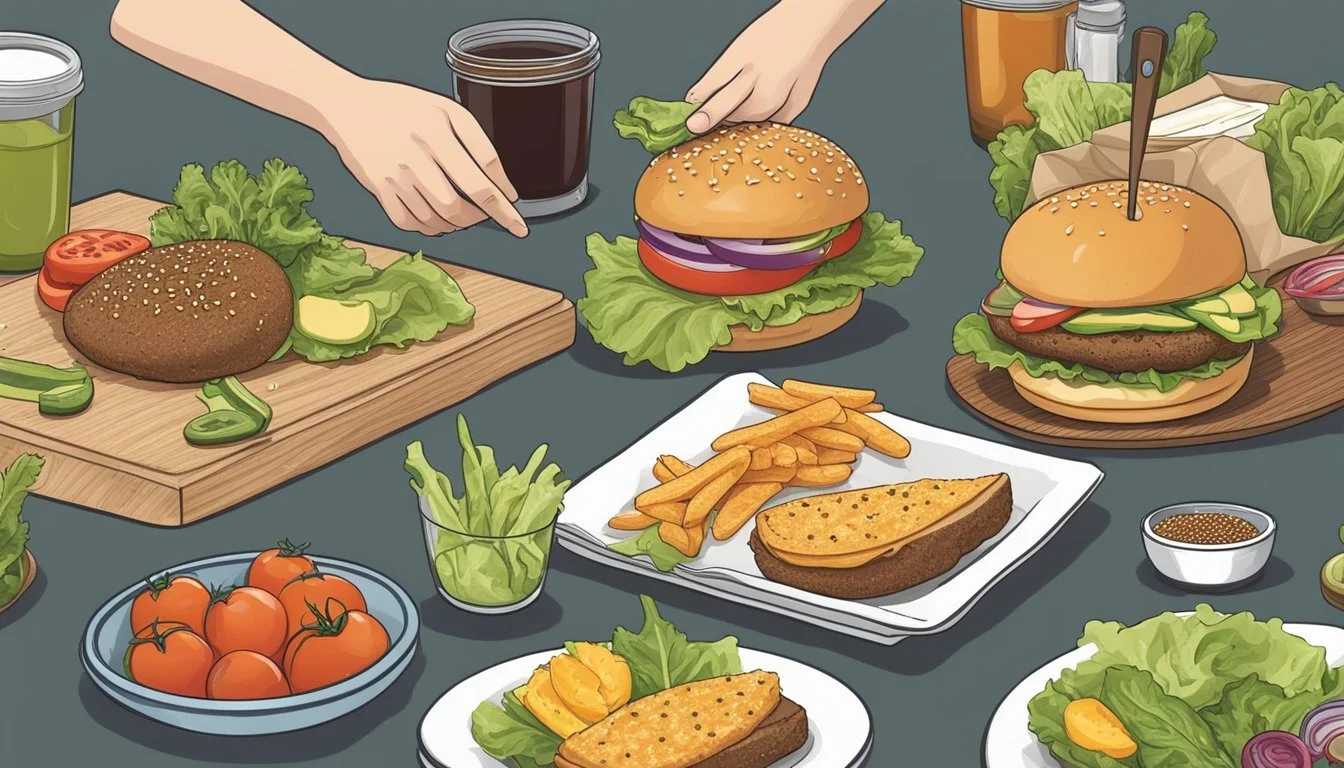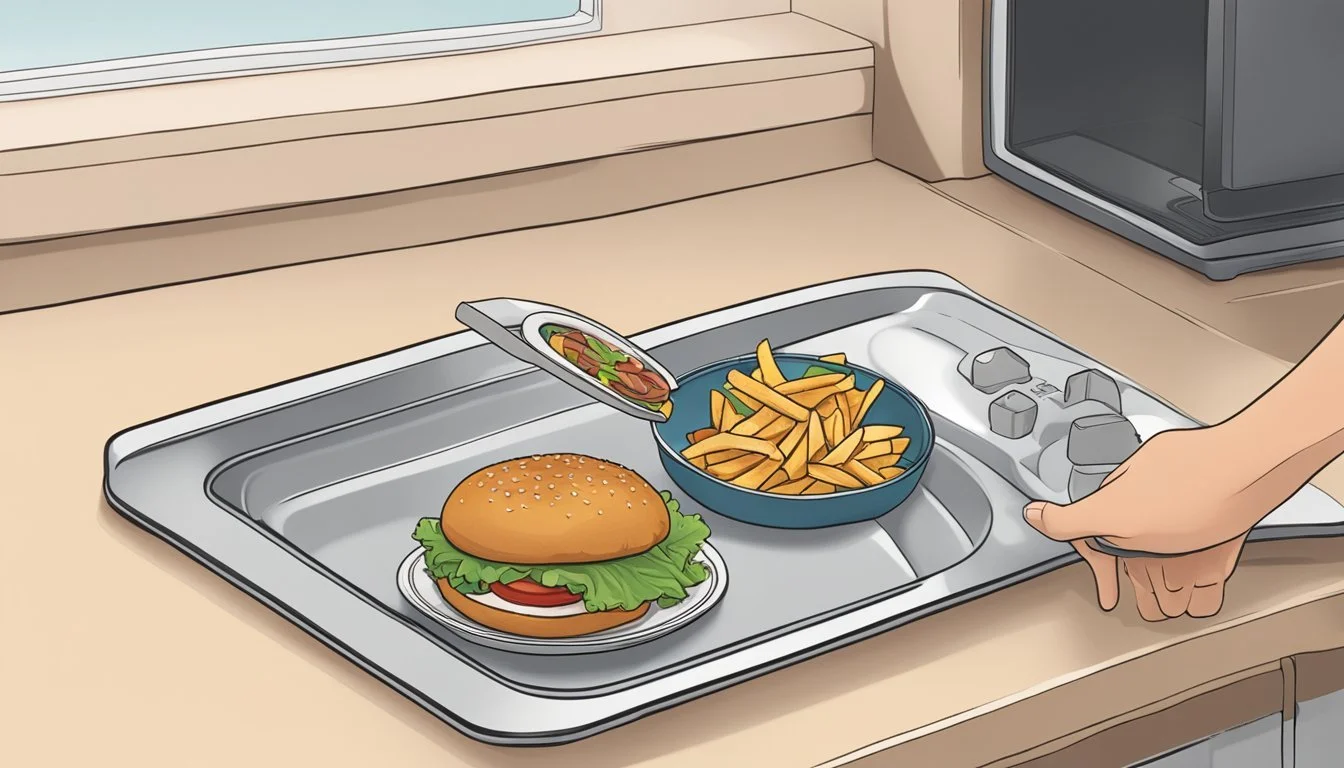How Do You Eat a Turkey Burger?
Mastering the Art of a Perfect Bite
Turkey (What wine goes well with turkey?) burgers offer a delicious and healthier alternative to traditional beef burgers. They are a great source of lean protein and can be a beneficial part of a balanced diet. Packed with essential nutrients, turkey burgers can be a nutritious meal choice because they contain less saturated fat and calories than their beef counterparts when prepared with lean ground turkey.
Eating a turkey burger can be just as enjoyable and versatile as enjoying a classic burger. For the best experience, it should be cooked to a safe internal temperature of 165°F, evidenced by clear juices when the patty is pressed. This ensures that the meat is no longer pink inside and has reached a safe temperature for consumption. Once properly cooked, they can be served on a whole-grain bun, garnished with a variety of toppings such as lettuce, tomatoes, onions, and avocado for additional nutrition and flavors.
Choosing Ingredients for Your Turkey Burger
Selecting the right ingredients is critical for creating a flavorful and juicy turkey burger. This section focuses on the turkey meat quality, the balance of ingredients, and the right combination of fats and seasonings to enhance the taste and texture of your burger.
Selecting the Right Ground Turkey
When it comes to the base of your turkey burger, ground turkey is the star ingredient. It's essential to understand the differences between lean and fattier cuts. Lean ground turkey, typically labeled as 99% fat-free, offers a healthier option with less saturated fat. However, a slightly higher fat content, like 93% lean ground turkey, can provide a juicier burger once cooked. The key is to strike a balance that aligns with one's dietary preferences and desired burger juiciness.
Fresh vs. Dry Ingredients
Incorporating the right mix of ingredients into your turkey burger recipe is vital for maximum flavor.
Fresh ingredients such as garlic, onion, and fresh parsley can greatly elevate the taste profile of your burger.
Dry ingredients, like onion powder and breadcrumbs, offer not only flavor but also help to bind the burger mixture, ensuring it holds together during cooking.
A well-thought-out combination of these can make the difference between a good and an exceptional turkey burger.
Understanding Fats and Seasonings
The judicious use of fats and seasonings is what can turn a bland turkey burger into a culinary delight. A moderate addition of fats, such as olive oil or a bit of butter, can counteract the leanness of the turkey, adding moisture and richness.
Seasonings like salt and pepper are the foundational spices, while garlic and onion powder can intensify the burger's savoriness.
For a well-seasoned patty, all seasonings should be mixed thoroughly with the ground turkey in a mixing bowl before forming the patties. This ensures each bite is seasoned to perfection.
Preparation Before Cooking
The preparation of a turkey burger involves careful attention to mixing ingredients and forming patties, as well as deciding whether to refrigerate them before cooking.
Mixing and Forming Patties
One begins by combining the ground turkey with the chosen seasonings and any additional ingredients, such as Worcestershire sauce or breadcrumbs, to enhance flavor and texture. If the recipe calls for it, an egg can be incorporated into the mixture to act as a binding agent. The chef should uniformly mix these ingredients, being careful not to overwork the meat, which can lead to tough burgers.
Next, they shape the mixture into patties that are about ½-inch larger in diameter than the buns they'll be served on. This accounts for the inevitable shrinkage that occurs during cooking. A common technique is to make a small indent in the center of each patty with a thumb, which prevents the burgers from puffing up too much as they cook.
To Refrigerate or Not
Contemplating whether to refrigerate the patties before cooking can affect the final results. Refrigerating the patties for a brief period can firm them up, making them easier to handle and less likely to fall apart on the grill or in the pan. It allows the flavors to meld well together, too. The ideal refrigeration time can vary, but a general guideline is to chill the patties for at least 30 minutes. If time doesn't permit, they can be cooked immediately after forming, though extra care must be taken to maintain their shape.
Cooking Methods
When cooking turkey burgers, it's crucial to reach an internal temperature of 165°F and to handle the burgers gently to retain their juiciness. Various cooking methods can be employed including grilling, skillet cooking, oven baking, and using an air fryer.
Grilling Perfect Turkey Burgers
Grilling imbues turkey burgers with a smoky flavor and a satisfying char. They should be grilled over medium heat, turning once. The ideal time on the grill is around 6-7 minutes per side. One should lightly oil the grill grates to prevent sticking. To add cheese, place it on the patties 2 minutes before they’re done.
Skillet Cooking
Skillet cooking on the stove offers a simple way to achieve a crispy crust with a juicy center. After preheating a skillet, often with a light coating of oil, over medium heat, the patties should be cooked for 5-7 minutes per side until fully done.
Oven Baking
For a hands-off approach, oven baking is efficient and can yield evenly cooked burgers. Patties should be placed on a parchment-lined baking sheet and baked in a preheated 350°F oven for about 15 minutes. No flipping is required.
Using an Air Fryer
Air fryers offer a fast, mess-free way to cook turkey burgers with minimal oil. The patties should be placed in the air fryer basket and cooked at the recommended temperature, typically around 375°F, for about 8-10 minutes, flipping halfway through the cooking time.
Understanding Cooking Temperatures and Times
When preparing a turkey burger, achieving the proper internal temperature is critical for both safety and quality. The United States Department of Agriculture (USDA) recommends that turkey burgers reach an internal temperature of 165 degrees Fahrenheit (74 degrees Celsius). This ensures that harmful bacteria are destroyed and the burger is safe to consume.
Cooking Times and Methods:
Stovetop (Pan-Frying):
Generally, it would take about 5 minutes per side on medium heat for the turkey burgers to be appropriately cooked through.Grilling:
Preheat the grill to medium heat. Grill the turkey burgers until the desired internal temperature is reached, typically within 8 to 10 minutes, flipping once halfway through.Oven Baking:
Preheat your oven to 375°F (190°C). Bake the turkey burgers for 15-20 minutes.
Note: The actual cooking time might vary depending on the thickness of the burger patties and individual oven or grill variations.
Temperature Check:
Utilize an instant-read meat thermometer by inserting the probe into the center of the burger at the thickest part to measure the internal temperature accurately.
It's beneficial to let the turkey burgers rest for a few minutes after cooking. This settling period allows for juices to redistribute, resulting in a moist and flavorful burger. Remember, color is not a reliable indicator of doneness; only temperature can guarantee that a turkey burger is thoroughly cooked.
Selecting Bun and Toppings
A successful turkey burger experience relies heavily on the choice of bun and array of toppings, which provide texture, flavor, and nutritional enhancement to the meal.
Choosing the Right Bun
The bun serves as the foundation of any burger and should complement the texture and flavor of the turkey patty. Whole wheat buns are a wholesome choice, offering a nutty flavor and firmer texture. For a softer option, potato buns add a slight sweetness and light texture that doesn't compete with the burger. Those seeking a lower-carb alternative might opt for lettuce wraps, which crisp freshness elevates the burger without the additional bread.
Variety in Toppings
Toppings bring excitement and personalize the burger experience. Classic tomato and lettuce add freshness and a contrasting crunch, while cheese offers a creamy melt that binds the layers. Pickles introduce a tangy bite and red onions contribute a sharp depth, whether raw for a pungent snap or caramelized for sweetness. Creative toppings like guacamole or avocado slices can offer a rich, creamy texture along with healthy fats.
Bold Flavors: Crisp bacon or a smear of mustard can intensify the taste.
Sweet Touches: Ketchup or sautéed onions balance with their natural sweetness.
Creamy Elements: Mayo can be used sparingly to add moisture and creaminess.
Making Healthier Choices
For those conscious about their health, there are numerous ways to enjoy a turkey burger without sacrificing flavor. Choose a bun that is high in fiber, low in sugar, and made from whole grains. Top the burger with plenty of fresh vegetables like lettuce, tomato, onions, and avocado for added vitamins and minerals. Opt for low-fat or fat-free cheese to reduce calorie and fat intake. Lastly, condiments like mustard and ketchup should be used in moderation, or one can substitute them with healthier options such as hummus or yogurt-based spreads.
Nutritional Information
When considering the nutritional profile of a turkey burger, it is typically recognized for its lower calorie content compared to its beef counterpart. A standard 4-ounce turkey burger patty generally contains about 200–217 calories. Protein is another significant component, comprising approximately 48% of the patty, which contributes to muscle repair and growth. Fat content can vary, but it represents about 52% of the caloric content, which includes both saturated and unsaturated fats.
In terms of specific nutrients, the turkey burger is a source of several. While it does contain cholesterol, the amount is often lower than that found in beef burgers. Carbohydrates are minimal, especially when consumed without a bun. Dietary fiber is usually not present unless additional ingredients such as whole grains are incorporated into the patty or included in a whole-grain bun.
Turkey burgers can also provide vitamins and minerals such as iron and potassium, essential for blood health and heart function, respectively. Some nutrient levels can be boosted by adding vegetables or cheese for calcium or vitamin C. The use of different seasonings and toppings can affect the sodium content.
Nutritional profiles can also change based on the cooking method and additional ingredients used. For instance, incorporating vegetables can increase fiber and vitamin content, while using condiments can add sugars and sodium. Therefore, individual preparation plays a significant role in determining the final nutritional value of a turkey burger.
Serving Suggestions
When enjoying a turkey burger, the sides and presentation can greatly enhance the dining experience. Opting for the right combination of flavors and textures can turn a simple meal into a culinary delight.
Pairing with Sides
Turkey burgers, with their lean profile, pair well with a variety of side dishes. Here are some popular options:
Potato-based: Classic French fries or sweet potato fries are a beloved choice. For a healthier twist, one might opt for oven-baked fries lightly seasoned with sea salt and thyme.
Salads: A crisp green salad, pasta salad, or even coleslaw can add a refreshing element to the meal. They offer a nice contrast to the savory burger.
Potato Salads: A creamy potato salad, sometimes infused with mustard or dill, complements the flavors of turkey very well.
Macaroni Salad: For a creamy, comforting side, macaroni salad is a crowd-pleaser that nicely balances out the burger's texture.
Presentation Tips
Presentation matters, and these tips can help ensure that a turkey burger meal is as visually appealing as it is delicious:
Place the burger on a toasted bun with crisp lettuce, bright red tomato slices, and a dollop of a condiment like mayonnaise or a special burger sauce.
Serve sides like fries or a salad in separate dishes or on the same plate but arranged neatly to avoid overcrowding.
Garnish the plate with a pickle spear or a few olives for an additional pop of color and flavor.
Storage and Reheating
Properly storing and reheating a turkey burger is crucial to maintaining its flavor and texture. This section breaks down best practices for freezing uncooked patties and provides guidance on how to reheat them without causing dryness.
How to Freeze Uncooked Patties
To freeze uncooked turkey burger patties, one should:
Place a sheet of parchment paper on a baking sheet.
Arrange the patties in a single layer on the sheet, ensuring they do not touch.
Freeze the patties on the baking sheet until solid, about 1-2 hours.
Transfer the frozen patties into a freezer bag, removing as much air as possible.
Label the bag with the date and return it to the freezer.
Note: Frozen uncooked turkey burger patties can be stored for up to 3-4 months.
Reheating Without Drying Out
When one wants to reheat a turkey burger without drying it out, the following steps should be taken:
Oven Method:
Preheat the oven to 350°F (175°C).
Place the turkey burger patties on a baking dish or sheet.
Cover with aluminum foil to trap moisture.
Heat for approximately 10-15 minutes or until thoroughly warmed.
Microwave Method:
Place the turkey burger on a microwave-safe plate.
Cover with a damp paper towel to retain moisture.
Use the reheat setting or 70% power and heat for 2-3 minutes, flipping halfway through.
In both methods, it's essential to check the burger's internal temperature, ensuring it has reached 165°F (74°C) for safe consumption.
Troubleshooting Common Issues
In crafting the perfect turkey burger, one may encounter issues such as patties falling apart or overcooking. This section provides guidance on preventing these common problems, ensuring a juicy and intact burger.
Preventing Patties from Falling Apart
To keep turkey burger patties from crumbling, one should ensure the ground turkey is mixed with the right binding agents. Ingredients like eggs, breadcrumbs, or even cooked quinoa (how long does cooked quinoa last?) can help hold the meat together. Be gentle when forming the patties; overworking the meat can make it tough, leading to a burger that doesn't hold its shape well. Additionally, refrain from flipping the burgers too soon; giving them time to form a crust on the grill or pan aids in keeping them intact.
Avoiding Overcooking
Turkey burgers should reach an internal temperature of 165°F to ensure they are cooked safely, but going far beyond this point can result in dry, overcooked meat. Using a meat thermometer is the most reliable way to prevent overcooking. Placing the thermometer into the thickest part of the patty ensures an accurate reading. Cook the burgers over medium heat, and once the internal temperature is approaching 165°F, remove them from the heat source. The residual heat will continue to cook the meat slightly, reaching the recommended temperature without exceeding it.
Alternative Options
When customizing a turkey burger, one can explore various dietary needs and preferences by switching out traditional components. These adaptations can cater to vegetarians, vegans, and those seeking gluten-free or low-carb alternatives while aiming for a leaner, potentially healthier burger experience.
Creating Vegetarian and Vegan Variations
To accommodate vegetarian diners, one can replace the turkey patty with a plant-based patty made from ingredients like lentils, black beans, or chickpeas. These options maintain the burger's substantial feel while being entirely meat-free. For a vegan alternative, one also needs to ensure that the burger buns are free from dairy and eggs. Additionally, they can opt for non-dairy cheese slices and mayonnaise substitutes made from plant-derived ingredients.
Sample Vegan Patty Components:
Gluten-Free and Low-Carb Substitutions
Individuals requiring gluten-free diets can enjoy a turkey burger by substituting regular buns with gluten-free alternatives made from rice or almond flour. Low-carb options include lettuce wraps or portobello mushroom caps in place of traditional bread buns, drastically reducing the carbohydrate content while adding a nutritional boost.
Gluten-Free Bun Ingredients:
Rice flour
Almond flour
Tapioca flour
Low-Carb Bun Alternatives:
Lettuce wraps
Portobello mushroom caps
Grilled eggplant (What wine goes well with grilled eggplant?) slices











